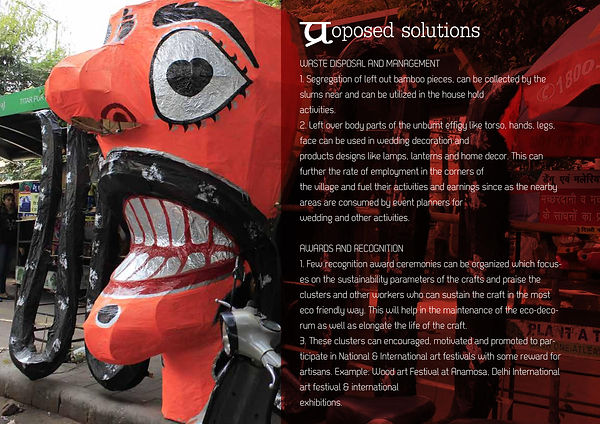Focus of the study
The focus of this project was to systematically explore the evolution and growth of the craft of Ravan Making in recent years, combining an analysis of the trends over the past few years with primary and secondary data to illuminate the sustainability of the craft. The objective is not only to increase our understanding but also to contribute to the debate about how a craft is measured on the 3 pillars of Sustainability and to evaluate its effect on the society as a whole.
Background
This project was done as a part of Craft Cluster studies for over a period of six weeks. In the days before Dussehra usually nondescript areas in the national capital, throbs with a final spurt of activity surrounding its one celebrated annual produce: the effigies of Ravan, the lord of Lanka.
This project aims to analyze how the 3 pillars of sustainability (social, economic and environmental) are put into consideration when it comes to practicing a craft form. It is a diagnostic study, based majorly on the basis of information taken through primary research. The chosen area comes under Delhi, the capital city of India which covers areas like Titarpur (Subhash Nagar), Daryaganj, Punjabi Bagh, Ramlila Maidaan, and Chandni Chowk. Exploratory research on “Ravan-Making” has been done to understand the lineage of this craft form.
Timeline
6 Weeks
My Key Role
Research, Interaction, Photography, Analysis Visual Design, Report Planning and Creation
Recognition
Shri Dharmik Ram Lila Committee
Nav Dharmik Ram Lila Committee
Luv Kush Ram Lila Committee
Punjabi Bagh Ram Lila Committee
Pitampura Ram Lila Committee
Subhash Nagar Ram Lila Committee
The Purpose
In different parts of India, huge effigies of Ravan, his giant brother Kumbhkarna and son Meghnath filled with firecrackers, are erected and then set on fire by the enthusiastic youth at sunset. In order to truly understand the impact of this fiesta, it was necessary to explore the process of the creation of such an ambiance in a holistic view.
Delimitations- This research was conducted with 25 craft families in the capital region of India
The Research Process
The project started with secondary assessment moving on to primary with identification of the master craftsmen of the cluster. The research was both qualitative as well as quantitative so as to procure the relevant information and knowledge about the craft of Ravana effigy from a range of stakeholders. Rapid ethnographic research was also conducted for a period of 5 weeks which included interaction, filming with closely analyzing the craft (preparations and execution) and craftsman with bound parameters of sustainability.






Primary Data Collection
Rapid Ethnography: 25 Families (300 people) Interactions, Filming, Photography, Partly Participant Observation, Shadowing
Synthesis and Analysis
For data analysis, sustainable approaches were taken into consideration like system thinking and life cycle analysis.







Proposed Solutions and Conclusion









